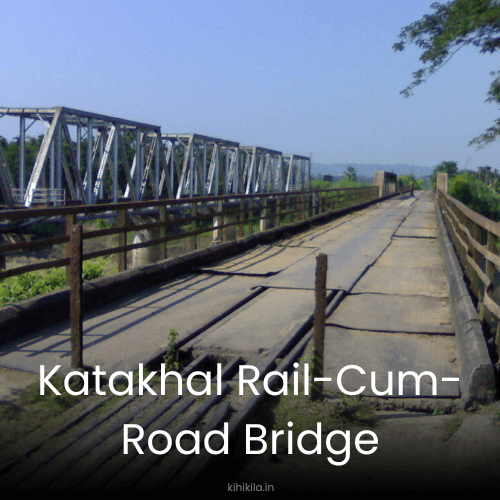The Katakhal Rail-Cum-Road Bridge, located on National Highway 44 near Badarpur in Assam’s Cachar district, holds a significant place in India’s history. It is one of the few bridges in the world where both railway and road transport shared the same level. Though it was once a crucial link for vehicles and trains, today, it is primarily used by pedestrians and two-wheelers due to structural concerns.
Built during British rule, this bridge spans the Katakhal River, connecting key locations like Shillong, Silchar, Aizawl (Mizoram), and Agartala (Tripura). It was an essential route for transportation and trade for decades, making it an engineering marvel of its time.
The Unique Design of Katakhal Bridge
Not Just a Regular Bridge
Unlike conventional bridges, the Katakhal Rail-Cum-Road Bridge did not have separate levels for road and railway tracks. Instead, both shared the same surface, making it unique. When a train was about to cross, vehicle movement was halted using level crossings at both ends. This design was rare and made traffic management a challenge, especially in its operational days.
A Historical Connection
Katakhal Rail-Cum-Road Bridge was built during the British colonial period, making it one of Assam’s oldest railway structures. It originally had meter-gauge tracks, which were later replaced with broad-gauge infrastructure by Northeast Frontier Railway (NFR). This transition helped improve railway connectivity in the region, but the bridge’s narrow and aged structure limited its ability to handle heavy traffic.
Importance of Katakhal Bridge in Northeast India
A Lifeline for Trade and Connectivity
Katakhal Rail-Cum-Road Bridge served as a crucial link connecting Assam, Meghalaya, Mizoram, and Tripura. Before modern alternatives were developed, it was the primary route for goods and passenger transport, playing a key role in trade and daily commutes.
One of the Last Active Rail-Cum-Road Bridges
While many such bridges worldwide have been phased out due to structural limitations, Katakhal Rail-Cum-Road Bridge remains one of the last existing ones in India. The only other similar bridge was in Punjab’s Ferozepur district, which is no longer in use.
Present Condition and Usage
Limited Usage for Safety Reasons
Due to its aging structure, the bridge is now restricted to pedestrians and two-wheelers. Heavy vehicles and trains no longer use it, as newer infrastructure has been built for modern transportation needs.
A Glimpse into the Past
Even though the Katakhal Rail-Cum-Road Bridge is no longer a major transport route, it remains a symbol of historical engineering. Locals still use it for crossing the Katakhal River, and it continues to be an important landmark in Assam’s transportation history.
Conclusion
The Katakhal Rail-Cum-Road Bridge is more than just a bridge—it is a piece of Assam’s history. Despite its limitations today, it once played a vital role in connecting the northeastern states. Its unique design and historical importance make it a fascinating topic for students and history enthusiasts alike.
FAQ’s:
Where is the Katakhal Rail-Cum-Road Bridge located?
The Katakhal Rail Cum-Road-Bridge is situated on National Highway No. 44 near Badarpur, close to Silchar town in Assam’s Cachar district. It serves as a link between various northeastern states.
Why is the Katakhal Rail-Cum-Road Bridge unique?
This bridge is one of the few in the world where both rail and road transport share the same path. Unlike other bridges where trains pass underneath or above the road, here, vehicles and trains use the same level.
Is the bridge still functional for vehicles and trains?
Currently, the bridge is too weak for heavy usage, so only pedestrians, two-wheelers, and light vehicles are allowed. Trains no longer operate on this bridge.
When was the bridge built?
The bridge was constructed during the British era and has been a significant part of Assam’s transportation network for decades.
Which states does the bridge connect?
How does the traffic system work on the bridge?
When the bridge was operational for both road and rail, traffic was halted at both ends whenever a train needed to pass. This ensured safety since both shared the same tracks.
Is there any other rail-cum-road bridge like this in India?
The only other similar bridge was located in Punjab’s Ferozepur district, but it is no longer in use. The Katakhal bridge remains one of the rare operational ones of its kind.
Has the bridge been replaced with a new one?
Yes, the N.F. Railway has constructed a broad-gauge railway bridge in Katakhal, which replaced the old meter-gauge tracks on the Katakhal Rail Cum Road Bridge.
Why is the bridge historically important?
Since its construction, the bridge has been a crucial link in Assam’s transportation system, connecting different regions and facilitating trade and travel for many years.
Can tourists visit the bridge?
Yes, visitors can explore the bridge, especially to witness its unique design and historical significance. However, as it is not in full operation, access may be limited to certain types of vehicles.



